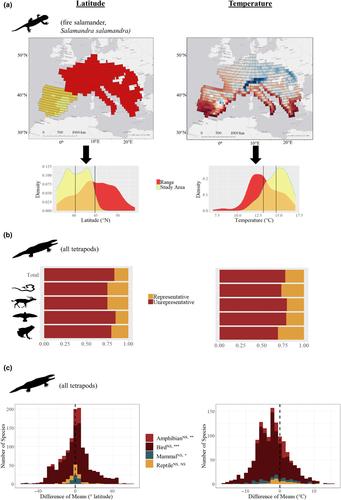当前位置:
X-MOL 学术
›
Glob. Change Biol.
›
论文详情
Our official English website, www.x-mol.net, welcomes your
feedback! (Note: you will need to create a separate account there.)
Insufficient and biased representation of species geographic responses to climate change
Global Change Biology ( IF 10.8 ) Pub Date : 2024-07-10 , DOI: 10.1111/gcb.17408 Evan J Parker 1, 2 , Sarah R Weiskopf 3 , Ruth Y Oliver 1, 2, 4 , Madeleine A Rubenstein 3 , Walter Jetz 1, 2
Global Change Biology ( IF 10.8 ) Pub Date : 2024-07-10 , DOI: 10.1111/gcb.17408 Evan J Parker 1, 2 , Sarah R Weiskopf 3 , Ruth Y Oliver 1, 2, 4 , Madeleine A Rubenstein 3 , Walter Jetz 1, 2
Affiliation

|
The geographic redistributions of species due to a rapidly changing climate are poised to perturb ecological communities and significantly impact ecosystems and human livelihoods. Effectively managing these biological impacts requires a thorough understanding of the patterns and processes of species geographic range shifts. While substantial recent redistributions have been identified and recognized to vary by taxon, region, and range geometry, there are large gaps and biases in the available evidence. Here, we use the largest compilation of geographic range change observations to date, comprised of 33,016 potential redistributions across 12,009 species, to formally assess within‐ and cross‐species coverage and biases and to motivate future data collection. We find that species coverage varies strongly by taxon and underrepresents species at high and low latitudes. Within species, assessments of potential redistributions came from parts of their geographic range that were highly uneven and non‐representative. For most species and taxa, studies were strongly biased toward the colder parts of species' distributions and thus significantly underrepresented populations that might get pushed beyond their maximum temperature limits. Coverage of potential leading and trailing geographic range edges under a changing climate was similarly uneven. Only 8% of studied species were assessed at both high and low latitude and elevation range edges, with most only covered at one edge. This suggests that substantial within‐species biases exacerbate the considerable geographic and taxonomic among‐species unevenness in evidence. Our results open the door for a more quantitative accounting for existing knowledge biases in climate change ecology and a more informed management and conservation. Our findings offer guidance for future data collection that better addresses information gaps and provides a more effective foundation for managing the biological impacts of climate change.
中文翻译:

物种对气候变化的地理反应代表性不足且存在偏见
气候快速变化导致的物种地理重新分布将扰乱生态群落,并对生态系统和人类生计产生重大影响。有效管理这些生物影响需要彻底了解物种地理范围变化的模式和过程。虽然最近大量的重新分布已被确定并认识到因分类单元、区域和分布范围的几何形状而异,但现有证据仍存在很大的差距和偏差。在这里,我们使用迄今为止最大的地理范围变化观测数据汇编,其中包括 12,009 个物种的 33,016 个潜在重新分布,以正式评估物种内和跨物种的覆盖范围和偏差,并激励未来的数据收集。我们发现物种覆盖率因分类单元而异,并且高低纬度地区的物种代表性不足。在物种内部,对潜在重新分配的评估来自其地理范围内高度不均匀且不具代表性的部分。对于大多数物种和类群,研究强烈偏向于物种分布的较冷部分,因此明显低估了可能超出其最高温度限制的种群。在不断变化的气候下,潜在的领先和落后地理范围边缘的覆盖范围同样不均匀。只有 8% 的研究物种在高纬度和低纬度以及海拔范围边缘进行了评估,其中大多数仅在一个边缘进行了评估。这表明,严重的种内偏差加剧了种间证据的相当大的地理和分类学不均匀性。 我们的结果为对气候变化生态学中现有的知识偏差进行更定量的核算以及更明智的管理和保护打开了大门。我们的研究结果为未来的数据收集提供了指导,更好地解决信息差距,并为管理气候变化的生物影响提供更有效的基础。
更新日期:2024-07-10
中文翻译:

物种对气候变化的地理反应代表性不足且存在偏见
气候快速变化导致的物种地理重新分布将扰乱生态群落,并对生态系统和人类生计产生重大影响。有效管理这些生物影响需要彻底了解物种地理范围变化的模式和过程。虽然最近大量的重新分布已被确定并认识到因分类单元、区域和分布范围的几何形状而异,但现有证据仍存在很大的差距和偏差。在这里,我们使用迄今为止最大的地理范围变化观测数据汇编,其中包括 12,009 个物种的 33,016 个潜在重新分布,以正式评估物种内和跨物种的覆盖范围和偏差,并激励未来的数据收集。我们发现物种覆盖率因分类单元而异,并且高低纬度地区的物种代表性不足。在物种内部,对潜在重新分配的评估来自其地理范围内高度不均匀且不具代表性的部分。对于大多数物种和类群,研究强烈偏向于物种分布的较冷部分,因此明显低估了可能超出其最高温度限制的种群。在不断变化的气候下,潜在的领先和落后地理范围边缘的覆盖范围同样不均匀。只有 8% 的研究物种在高纬度和低纬度以及海拔范围边缘进行了评估,其中大多数仅在一个边缘进行了评估。这表明,严重的种内偏差加剧了种间证据的相当大的地理和分类学不均匀性。 我们的结果为对气候变化生态学中现有的知识偏差进行更定量的核算以及更明智的管理和保护打开了大门。我们的研究结果为未来的数据收集提供了指导,更好地解决信息差距,并为管理气候变化的生物影响提供更有效的基础。
















































 京公网安备 11010802027423号
京公网安备 11010802027423号